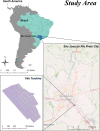Cryptic circulation of chikungunya virus in São Jose do Rio Preto, Brazil, 2015-2019
- PMID: 38484018
- PMCID: PMC10965090
- DOI: 10.1371/journal.pntd.0012013
Cryptic circulation of chikungunya virus in São Jose do Rio Preto, Brazil, 2015-2019
Abstract
Background: Chikungunya virus (CHIKV) has spread across Brazil with varying incidence rates depending on the affected areas. Due to cocirculation of arboviruses and overlapping disease symptoms, CHIKV infection may be underdiagnosed. To understand the lack of CHIKV epidemics in São José do Rio Preto (SJdRP), São Paulo (SP), Brazil, we evaluated viral circulation by investigating anti-CHIKV IgG seroconversion in a prospective study of asymptomatic individuals and detecting anti-CHIKV IgM in individuals suspected of dengue infection, as well as CHIKV presence in Aedes mosquitoes. The opportunity to assess two different groups (symptomatic and asymptomatic) exposed at the same geographic region aimed to broaden the possibility of identifying the viral circulation, which had been previously considered absent.
Methodology/principal findings: Based on a prospective population study model and demographic characteristics (sex and age), we analyzed the anti-CHIKV IgG seroconversion rate in 341 subjects by ELISA over four years. The seroprevalence increased from 0.35% in the first year to 2.3% after 3 years of follow-up. Additionally, we investigated 497 samples from a blood panel collected from dengue-suspected individuals during the 2019 dengue outbreak in SJdRP. In total, 4.4% were positive for anti-CHIKV IgM, and 8.6% were positive for IgG. To exclude alphavirus cross-reactivity, we evaluated the presence of anti-Mayaro virus (MAYV) IgG by ELISA, and the positivity rate was 0.3% in the population study and 0.8% in the blood panel samples. In CHIKV and MAYV plaque reduction neutralization tests (PRNTs), the positivity rate for CHIKV-neutralizing antibodies in these ELISA-positive samples was 46.7%, while no MAYV-neutralizing antibodies were detected. Genomic sequencing and phylogenetic analysis revealed CHIKV genotype ECSA in São José do Rio Preto, SP. Finally, mosquitoes collected to complement human surveillance revealed CHIKV positivity of 2.76% of A. aegypti and 9.09% of A. albopictus (although it was far less abundant than A. aegypti) by RT-qPCR.
Conclusions/significance: Our data suggest cryptic CHIKV circulation in SJdRP detected by continual active surveillance. These low levels, but increasing, of viral circulation highlight the possibility of CHIKV outbreaks, as there is a large naïve population. Improved knowledge of the epidemiological situation might aid in outbreaks prevention.
Copyright: © 2024 Zini et al. This is an open access article distributed under the terms of the Creative Commons Attribution License, which permits unrestricted use, distribution, and reproduction in any medium, provided the original author and source are credited.
Conflict of interest statement
The authors have declared that no competing interests exist.
Figures






Similar articles
-
Development of an affordable multiplex quantitative RT-PCR assay for early detection and surveillance of Dengue, Chikungunya, and co-infections from clinical samples in resource-limited settings.PLoS Negl Trop Dis. 2025 Aug 11;19(8):e0013250. doi: 10.1371/journal.pntd.0013250. eCollection 2025 Aug. PLoS Negl Trop Dis. 2025. PMID: 40788955 Free PMC article.
-
Retrospective Study of Arbovirus Circulation in Northeast Brazil in 2019 and 2022: Insights into the Re-Emergence of DENV-3 and the Co-Infection of DENV-1 and CHIKV.Viruses. 2025 Mar 26;17(4):475. doi: 10.3390/v17040475. Viruses. 2025. PMID: 40284918 Free PMC article.
-
Chikungunya in a pediatric cohort: Asymptomatic infection, seroconversion, and chronicity rates.PLoS Negl Trop Dis. 2025 Jul 16;19(7):e0013254. doi: 10.1371/journal.pntd.0013254. eCollection 2025 Jul. PLoS Negl Trop Dis. 2025. PMID: 40668874 Free PMC article.
-
Antibody tests for identification of current and past infection with SARS-CoV-2.Cochrane Database Syst Rev. 2022 Nov 17;11(11):CD013652. doi: 10.1002/14651858.CD013652.pub2. Cochrane Database Syst Rev. 2022. PMID: 36394900 Free PMC article.
-
The effect of sample site and collection procedure on identification of SARS-CoV-2 infection.Cochrane Database Syst Rev. 2024 Dec 16;12(12):CD014780. doi: 10.1002/14651858.CD014780. Cochrane Database Syst Rev. 2024. PMID: 39679851 Free PMC article.
Cited by
-
(Re)Emerging Arboviruses of Public Health Significance in the Brazilian Amazon.Microorganisms. 2025 Mar 12;13(3):650. doi: 10.3390/microorganisms13030650. Microorganisms. 2025. PMID: 40142542 Free PMC article. Review.
-
From bench to clinic: the development of VLA1553/IXCHIQ, a live-attenuated chikungunya vaccine.J Travel Med. 2024 Oct 19;31(7):taae123. doi: 10.1093/jtm/taae123. J Travel Med. 2024. PMID: 39255380 Free PMC article. Review.
-
Entomological surveillance during a major CHIKV outbreak in northwestern São Paulo: insights from São José do Rio Preto.medRxiv [Preprint]. 2024 Dec 6:2024.12.04.24318429. doi: 10.1101/2024.12.04.24318429. medRxiv. 2024. PMID: 39677444 Free PMC article. Preprint.
References
-
- Vega-Rúa A, Zouache K, Girod R, Failloux A B, Lourenço-de-Oliveira R. High level of vector competence of Aedes aegypti and Aedes albopictus from ten American countries as a crucial factor in the spread of chikungunya virus. J Virol. 2014;88(11):6294–306. Epub 20140326. doi: 10.1128/JVI.00370-14 ; PubMed Central PMCID: PMC4093877. - DOI - PMC - PubMed
-
- Moizéis R N C, Fernandes T A A M, Guedes P M D M, Pereira H W B, Lanza D C F, Azevedo J W V, et al.. Chikungunya fever: a threat to global public health. Pathog Glob Health. 2018;112(4):182–94. Epub 20180528. doi: 10.1080/20477724.2018.1478777 ; PubMed Central PMCID: PMC6147074. - DOI - PMC - PubMed
-
- Cunha M S, Costa P A G, Correa I A, de Souza M R M, Calil P T, da Silva G P D, et al.. Chikungunya virus: an emergent arbovirus to the South American continent and a continuous threat to the world. Front Microbiol. 2020;11:1297. Epub 20200626. doi: 10.3389/fmicb.2020.01297 ; PubMed Central PMCID: PMC7332961. - DOI - PMC - PubMed
MeSH terms
Substances
Grants and funding
LinkOut - more resources
Full Text Sources
Medical

